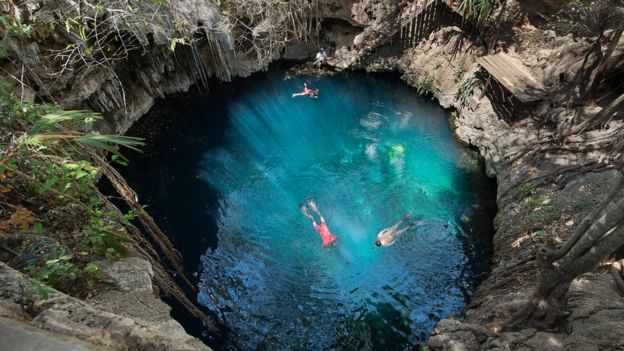The T. rex chomped with the bone-crunching force of three cars
from USA Today
Call it the big chomp.
The T. rex was impressive in its might and so was its bite —more than twice as bone-crunching as the bite of its relative, the fearsome crocodile, a Florida State University researcher found.
Without a doubt, much of the Tyrannosaurus rex's attraction is its reported mammoth size: 40 feet long, up to 20 feet tall, a 5-foot long skull and weighing over 7 tons. But a new study by Gregory Erickson, a professor of biological science at FSU and Paul Gignac, assistant professor of anatomy and vertebrate paleontology at Oklahoma State University, sheds new light on the power of T. rex's formidable chomp.
Ferocious is one way to describe it.
The study, published Wednesday in Scientific Reports, says the T. rex, or "king of the tyrant lizards" dominated anything in its way with its ability to bite down with "nearly 8,000 pounds of force, which is more than two times greater than the bite force of the largest living crocodiles," considered to be the strongest bite force creatures of the modern day.
The study also says the dinosaur's conical teeth "generated an astounding 431,000 pounds per square inch of bone-failing tooth pressures."
This force allowed T. rex to drive open cracks in bone during repetitive, mammal-like biting, leading to a catastrophic explosion of some bones of its prey, Erickson and his collaborator found.
"It was this bone-crunching acumen that helped T. rex to more fully exploit the carcasses of large horned dinosaurs and duck-billed hadrosaurids whose bones, rich in mineral salts and marrow, were unavailable to smaller, less equipped carnivorous dinosaurs," said Gignac, who earned his Ph.D. in biological sciences from FSU in 2010.
The researchers built on their extensive experience testing and modeling of how the musculature of living crocodiles, which are relatives of dinosaurs, contribute to biting forces. They then compared the results with birds, which are modern-day dinosaurs, and generated a model for T. rex.
From their work on crocodilians, they learned high bite forces were only part of the story. To understand how the giant dinosaur consumed bone, Erickson and Gignac also needed to understand how power was transmitted through the teeth, a measurement they call tooth pressure.
"Having high bite force doesn't necessarily mean an animal can puncture hide or pulverize bone. Tooth pressure is the biomechanically more relevant parameter," said Erickson, one of the nation's leading paleontologists. "It is like assuming a 600-horsepower engine guarantees speed. In a Ferrari, sure, but not for a dump truck."
In explaining the significance of the study, Erickson gave a sense of the outlandish power T.rex displayed.
"Eight thousand pounds of force is over twice what the largest crocodiles can generate," he said. "We recorded a world record bite force for living animals in a 17-foot Australian saltwater crocodile."
To simplify it, Erickson put the numbers in everyday context: 8,000 pounds of force, he said, is the equivalent weight of three small cars.
Regarding the dinosaurs' ability to pulverize bones, Erickson said, "We show that it did it through a combination of prodigious bite forces, robust tooth form, and tooth arrangements in the jaws that collectively enabled bone pulverizing pressures.
"T. rex could pretty much bite through the hides and pulverize the bones of any animal unlucky enough to find itself in its maw."
Erickson, whose primary area of research includes archosaurian reptiles — crocodiles, non-avian and avian dinosaurs (birds), and pterosaurs, said studies like this help to expand knowledge about the most fearsome creatures that have ever walked the earth.
"I think as children we are fascinated with all the world has to offer and are introduced to amazing creatures like monsters and dragons in movies, only to have our parents tell us that they aren't real," he said. "Then we learn about dinosaurs and are told they are real — and safe because they are extinct. T. rex being among the largest predators of all time gets the most attention."
from USA Today
Call it the big chomp.
The T. rex was impressive in its might and so was its bite —more than twice as bone-crunching as the bite of its relative, the fearsome crocodile, a Florida State University researcher found.
Without a doubt, much of the Tyrannosaurus rex's attraction is its reported mammoth size: 40 feet long, up to 20 feet tall, a 5-foot long skull and weighing over 7 tons. But a new study by Gregory Erickson, a professor of biological science at FSU and Paul Gignac, assistant professor of anatomy and vertebrate paleontology at Oklahoma State University, sheds new light on the power of T. rex's formidable chomp.
Ferocious is one way to describe it.
The study, published Wednesday in Scientific Reports, says the T. rex, or "king of the tyrant lizards" dominated anything in its way with its ability to bite down with "nearly 8,000 pounds of force, which is more than two times greater than the bite force of the largest living crocodiles," considered to be the strongest bite force creatures of the modern day.
The study also says the dinosaur's conical teeth "generated an astounding 431,000 pounds per square inch of bone-failing tooth pressures."
This force allowed T. rex to drive open cracks in bone during repetitive, mammal-like biting, leading to a catastrophic explosion of some bones of its prey, Erickson and his collaborator found.
"It was this bone-crunching acumen that helped T. rex to more fully exploit the carcasses of large horned dinosaurs and duck-billed hadrosaurids whose bones, rich in mineral salts and marrow, were unavailable to smaller, less equipped carnivorous dinosaurs," said Gignac, who earned his Ph.D. in biological sciences from FSU in 2010.
The researchers built on their extensive experience testing and modeling of how the musculature of living crocodiles, which are relatives of dinosaurs, contribute to biting forces. They then compared the results with birds, which are modern-day dinosaurs, and generated a model for T. rex.
From their work on crocodilians, they learned high bite forces were only part of the story. To understand how the giant dinosaur consumed bone, Erickson and Gignac also needed to understand how power was transmitted through the teeth, a measurement they call tooth pressure.
"Having high bite force doesn't necessarily mean an animal can puncture hide or pulverize bone. Tooth pressure is the biomechanically more relevant parameter," said Erickson, one of the nation's leading paleontologists. "It is like assuming a 600-horsepower engine guarantees speed. In a Ferrari, sure, but not for a dump truck."
In explaining the significance of the study, Erickson gave a sense of the outlandish power T.rex displayed.
"Eight thousand pounds of force is over twice what the largest crocodiles can generate," he said. "We recorded a world record bite force for living animals in a 17-foot Australian saltwater crocodile."
To simplify it, Erickson put the numbers in everyday context: 8,000 pounds of force, he said, is the equivalent weight of three small cars.
Regarding the dinosaurs' ability to pulverize bones, Erickson said, "We show that it did it through a combination of prodigious bite forces, robust tooth form, and tooth arrangements in the jaws that collectively enabled bone pulverizing pressures.
"T. rex could pretty much bite through the hides and pulverize the bones of any animal unlucky enough to find itself in its maw."
Erickson, whose primary area of research includes archosaurian reptiles — crocodiles, non-avian and avian dinosaurs (birds), and pterosaurs, said studies like this help to expand knowledge about the most fearsome creatures that have ever walked the earth.
"I think as children we are fascinated with all the world has to offer and are introduced to amazing creatures like monsters and dragons in movies, only to have our parents tell us that they aren't real," he said. "Then we learn about dinosaurs and are told they are real — and safe because they are extinct. T. rex being among the largest predators of all time gets the most attention."









:format(webp)/cdn0.vox-cdn.com/uploads/chorus_image/image/54794177/GettyImages_619566940.0.jpg)
/cdn0.vox-cdn.com/uploads/chorus_asset/file/8522149/GettyImages_680463736.jpg)
/cdn0.vox-cdn.com/uploads/chorus_asset/file/8522153/GettyImages_681974904.jpg)
/cdn0.vox-cdn.com/uploads/chorus_asset/file/8522157/GettyImages_56517727.jpg)
/cdn0.vox-cdn.com/uploads/chorus_asset/file/8522165/GettyImages_450451200.jpg)
/cdn0.vox-cdn.com/uploads/chorus_asset/file/8522179/GettyImages_626300460.jpg)
/cdn0.vox-cdn.com/uploads/chorus_asset/file/8522245/AP_11101319768.jpg)
/cdn0.vox-cdn.com/uploads/chorus_asset/file/8522233/AP_17133657276749.jpg)
/cdn0.vox-cdn.com/uploads/chorus_asset/file/8522213/GettyImages_480481021.jpg)







